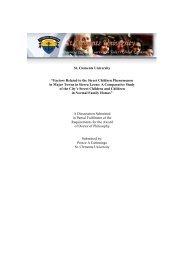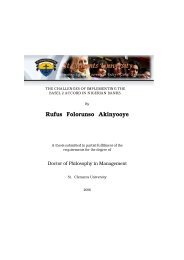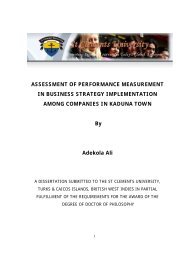The role of informal microfinance institutions in saving
The role of informal microfinance institutions in saving
The role of informal microfinance institutions in saving
You also want an ePaper? Increase the reach of your titles
YUMPU automatically turns print PDFs into web optimized ePapers that Google loves.
4.1.2: Responses to Questionnaire.<br />
<strong>The</strong> study recognized the importance <strong>of</strong> determ<strong>in</strong><strong>in</strong>g the response rate <strong>in</strong> order to validate and<br />
justify the f<strong>in</strong>d<strong>in</strong>gs.<br />
4.1.3: Bus<strong>in</strong>ess Environment.<br />
<strong>The</strong> environment <strong>in</strong> which SACCOs operates is very crucial for their growth and development<br />
as well as their contribution to the overall economic development <strong>of</strong> the country. Institutions<br />
and bus<strong>in</strong>esses <strong>in</strong>teract daily at different levels. <strong>The</strong>se range from direct contacts such as<br />
issuance <strong>of</strong> bus<strong>in</strong>ess licenses to much more <strong>in</strong>direct channels <strong>of</strong> government actions <strong>in</strong>clud<strong>in</strong>g<br />
effect <strong>of</strong> fiscal and monetary policies.<br />
<strong>The</strong> challenge <strong>of</strong> this study was to determ<strong>in</strong>e the perception <strong>of</strong> SACCOs <strong>of</strong> their operat<strong>in</strong>g<br />
environment and come up with strategies that will support SACCOs to grow and improve<br />
their performance with<strong>in</strong> their doma<strong>in</strong> <strong>of</strong> operations.<br />
<strong>The</strong> study therefore attempts to evaluate the legal framework, bus<strong>in</strong>ess regulation, Taxation,<br />
Microeconomic policy, bus<strong>in</strong>ess culture and <strong>in</strong>frastructure as they affect Sacco’s operations.<br />
Responses<br />
Rural F<strong>in</strong>ancial Institutions are the cornerstone <strong>of</strong> f<strong>in</strong>anc<strong>in</strong>g rural development and micro-<br />
enterprises <strong>in</strong> develop<strong>in</strong>g countries. Small farmers and the poor require the support <strong>of</strong><br />
the rural f<strong>in</strong>ancial <strong><strong>in</strong>stitutions</strong> <strong>in</strong> order to f<strong>in</strong>ance their development programmes.<br />
In the words <strong>of</strong> Padmanabhan (1988: 10) ‘’Lack <strong>of</strong> economic growth was seen as a<br />
consequence <strong>of</strong> shortage <strong>of</strong> physical capital. A vicious cycle low capital, low <strong>in</strong>comes,<br />
low sav<strong>in</strong>gs and consequent low capital seemed to be operat<strong>in</strong>g <strong>in</strong> rural areas. It was<br />
this th<strong>in</strong>k<strong>in</strong>g and reason<strong>in</strong>g <strong>of</strong> 1950’s which led to the mushroom<strong>in</strong>g <strong>of</strong> specialized<br />
rural f<strong>in</strong>ancial <strong><strong>in</strong>stitutions</strong> .<strong>The</strong> logic <strong>of</strong> traditional rural credit f<strong>in</strong>anc<strong>in</strong>g based on the<br />
follow<strong>in</strong>g assumptions;<br />
Assumptions related to saver /borrower behavior are that the rural poor can not save<br />
and therefore will not respond to sav<strong>in</strong>g <strong>in</strong>centives, and the farmers need cheap loans<br />
179
















